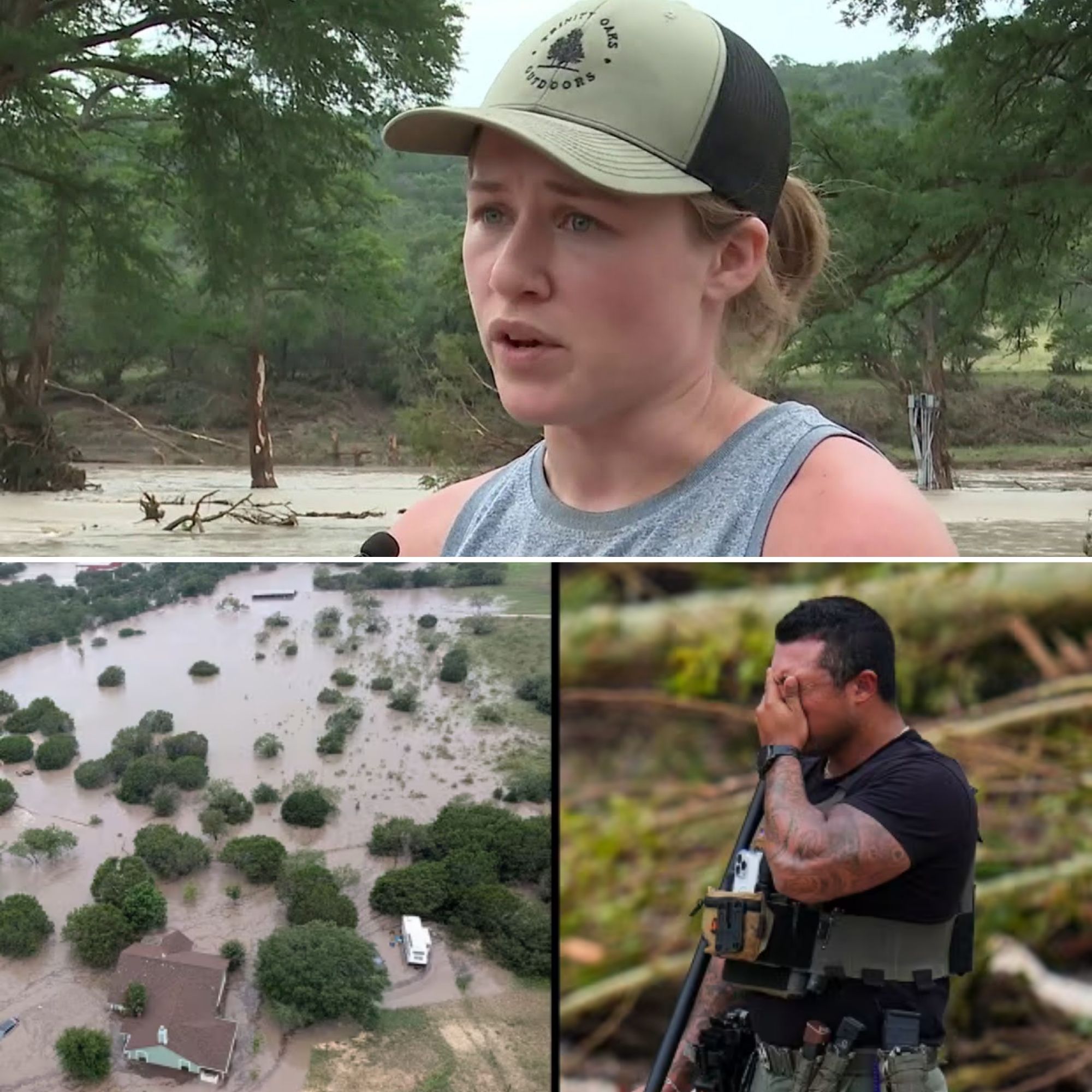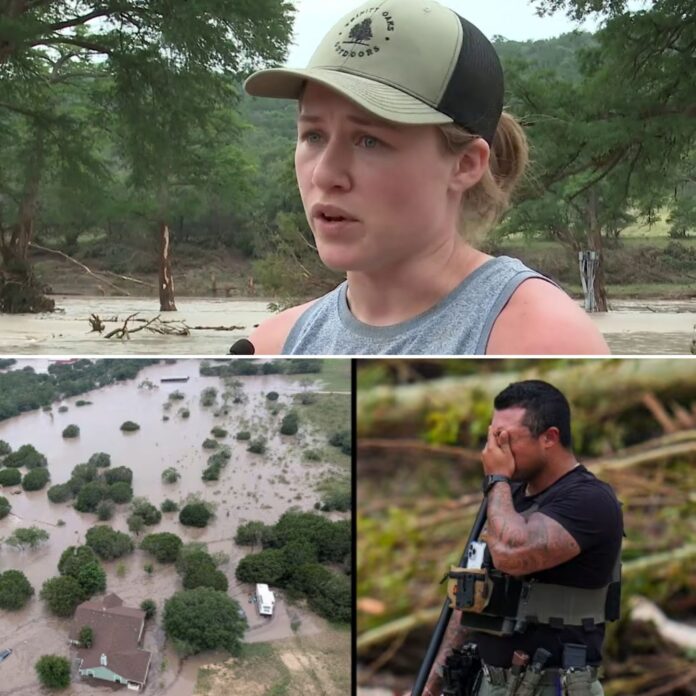🌊 “Screams piercing the darkness, cries for help I couldn’t answer…” An Ingram woman’s nightmare escape from Texas floods that devoured everything. What horrors did she witness floating away? The echoes still chill her soul… Unravel her gripping tale of survival.

The serene beauty of the Texas Hill Country, with its meandering rivers and verdant landscapes, belies a deadly undercurrent that surfaces with terrifying frequency. On July 4, 2025, during what should have been a joyous Independence Day weekend, a catastrophic flash flood ravaged the Guadalupe River basin, turning holiday celebrations into scenes of unimaginable horror. Kerr County, particularly the town of Ingram, became an epicenter of devastation, where over 100 lives were lost, and communities were left in ruins. Among the survivors is Julia Hatfield, an Ingram resident whose vivid recollections of screams and cries for help encapsulate the raw terror of that night. Her story, one of narrow escape and lingering trauma, sheds light on the human toll of the disaster and the resilience required to rebuild.
The Prelude to Catastrophe: Nature’s Sudden Wrath
Flash floods in Central Texas are not uncommon, owing to the region’s unique geology. The Hill Country’s thin soil layer atop limestone bedrock allows little absorption of heavy rainfall, channeling water swiftly into rivers like the Guadalupe. Historical floods, such as those in 1978 and 2015, have claimed lives and property, yet the 2025 event stood out for its ferocity and timing. A stalled weather system dumped torrential rains—up to two feet in hours—overnight on July 3 into July 4, swelling the river to unprecedented levels. In Ingram, a small community west of Kerrville, the Guadalupe rose over 20 feet in mere minutes, catching residents and vacationers off guard.
The HTR Texas Hill Country Campgrounds and adjacent Blue Oak RV Park, nestled along the riverbank, were packed with families enjoying the holiday. More than 20 RVs and numerous cabins housed campers drawn to the area’s scenic allure for tubing, barbecues, and fireworks. Julia Hatfield and her husband were among them, residing in their RV at the campground. What began as a peaceful night shattered around 4 a.m. when the first signs of trouble emerged—not with a gradual rise, but with a violent surge that announced itself through human desperation.
Julia Hatfield’s Ordeal: Screams in the Night
Julia Hatfield’s account begins with the abrupt awakening to chaos. “As we were rushing out, I could see all the RVs were gone and cabins were floating by,” she recalled, her voice steady but shadowed by the memory. The water had transformed the familiar landscape into a churning abyss, sweeping away vehicles, structures, and people with indifferent force. But it was the sounds that etched deepest into her psyche: “I could hear screams and even saw a child get swept away. Thankfully, he survived.” The cries for help echoed from the darkness, mingling with the roar of the floodwaters, creating a symphony of terror that Hatfield describes as unforgettable.
In the pitch-black early hours, visibility was limited, but the glimpses Hatfield caught were harrowing. Cabins, once sturdy retreats, bobbed like debris in the current, their occupants clinging desperately or vanishing into the torrent. RVs, including those neighboring hers, were uprooted and carried downstream, some with families inside. Hatfield and her husband acted swiftly, evacuating their RV just as the waters encroached. They waded through rising currents, the cold grip of the flood pulling at their legs, while around them, the campground disintegrated. “It was like the river just decided to reclaim everything,” she said, reflecting on the speed of the destruction.
Hatfield’s escape was a testament to quick thinking and luck. As they fled to higher ground, she witnessed scenes that would haunt her: silhouettes of people flailing in the water, their pleas cutting through the night. One particularly vivid moment involved spotting a young child being pulled away by the current; miraculously, rescuers later confirmed his survival, a rare bright spot in the tragedy. The Hatfields reached safety, but not without loss—their RV, home to cherished memories, was among the casualties, reduced to a slab of concrete where it once stood. “We lost our home on wheels, but we’re alive,” Hatfield emphasized, her gratitude tempered by sorrow for those less fortunate.
Her story aligns with others from the campground, where the holiday crowd amplified the scale of the loss. Families reported similar awakenings to screams, with some forming human chains to rescue strangers. A nearby resident described hearing “blood-curdling yells” as cabins collapsed, while another saw furniture and trees tumbling downstream like matchsticks. The campground, a hub for Fourth of July festivities, became a graveyard of twisted metal and splintered wood, with an unknown number still missing days later.
The Broader Impact: A Region in Mourning
The floods’ reach extended far beyond Ingram, devastating Kerr County and surrounding areas like Hunt, Comfort, and Center Point. Over 135 lives were claimed, many children at summer camps along the river. The Guadalupe’s wrath obliterated bridges, homes, and businesses, displacing thousands and inflicting billions in economic damage. Tourism, the lifeblood of the Hill Country, screeched to a halt as river outfitters and lodges lay in ruins. Farms flooded, livestock perished, and infrastructure crumbled, leaving roads impassable and power outages widespread.
Personal tragedies compounded the communal grief. In nearby camps, survivors recounted swimming through chest-deep waters, clinging to trees for hours, or watching loved ones swept away. One woman treaded water for over 20 miles before being rescued, her cries for help finally answered by a civilian hero. Families grappled with unimaginable loss—a mother learning of her child’s death via phone, or siblings separated in the chaos. Psychological scars run deep: nightmares of rushing water, anxiety at the sound of rain, and survivor’s guilt plague many, including Hatfield, who admits the screams replay in her mind.
Communities rallied in the aftermath, with volunteers from across Texas aiding in cleanup and support. Churches organized relief drives, and locals shared stories of heroism, like the man who risked his life to save a stranger from a tree. Yet, controversies simmered over preparedness—why weren’t warnings heeded sooner? Meteorological alerts were issued, but the holiday’s distractions may have contributed to delayed evacuations.
Response and Recovery: From Rescue to Rebuilding
Rescue operations shifted to recovery by mid-July, with teams using drones and boats to search debris-strewn riverbanks. First responders faced ongoing rains and treacherous terrain, recovering bodies and assessing damage. Federal and state aid flowed in, but bureaucratic hurdles slowed distribution, prompting grassroots efforts like GoFundMe campaigns and community fundraisers. “Texans helping Texans” became a rallying cry, exemplified by a young girl’s handmade bracelets for rescuers or church groups mobilizing cleanup crews.
Hatfield, now focused on rebuilding, advocates for better awareness. “We need to respect the river’s power,” she says, urging improved early-warning systems and education on flood risks. Experts echo this, noting climate change’s role in intensifying storms. Proposals include expanding siren networks, enhancing river gauges, and relocating vulnerable campsites. Environmentalists call for preserving natural buffers like riparian zones to mitigate runoff, countering urbanization’s effects.
Lessons from the Flood: Honoring the Lost Through Action
The July 2025 floods serve as a poignant reminder of nature’s unpredictability and the need for vigilance. In Ingram and beyond, the disaster tested human endurance, revealing both vulnerability and strength. Hatfield’s haunting recollections—those piercing screams and cries—underscore the urgency of prevention. As one survivor reflected, “July 4th will never be the same; it’s now a day to remember and prepare.”
Recovery continues, with the Hill Country’s scars slowly healing. Economic revival hinges on tourism’s return, bolstered by infrastructure upgrades. Psychologically, counseling services address the trauma, helping survivors like Hatfield process the echoes of that night. Globally, parallels to floods elsewhere highlight shared climate challenges, urging collective action.
In the end, stories like Hatfield’s transform tragedy into a catalyst for change. The Guadalupe River, once a source of leisure, now symbolizes resilience. By investing in safeguards—better mapping, community drills, and sustainable development—Texas can honor the lost and protect future generations. The screams may fade, but the lessons must endure, ensuring no more cries go unanswered in the face of the next storm.
To deepen the narrative, consider the environmental backdrop: The Guadalupe spans 230 miles, its volatility worsened by development stripping away absorption areas. Other anecdotes enrich the tapestry—a father sacrificing himself for his family, teenagers improvising escapes. The economic blow, estimated at $2.5 billion, spurs calls for mandatory flood insurance and smart tech for real-time alerts.
Hatfield’s gratitude shines through: “We’re rebuilding, one day at a time.” Her words inspire hope, proving that even amid devastation, the human spirit rises. As the Hill Country rebuilds, it stands as a beacon of unity, forever altered by the floods but stronger for the trials endured.
